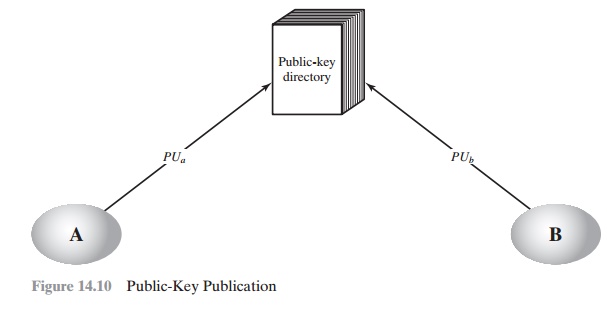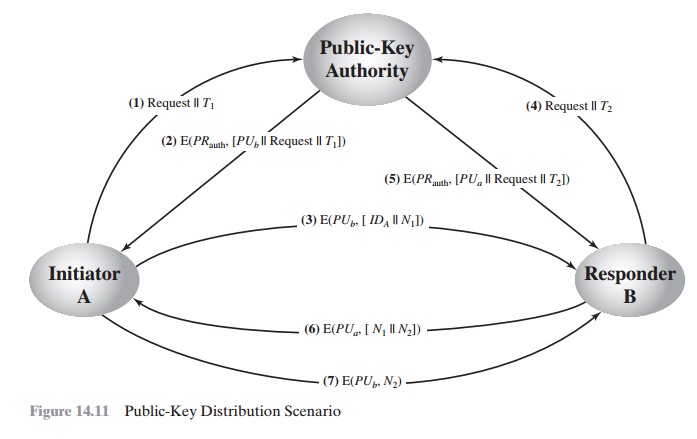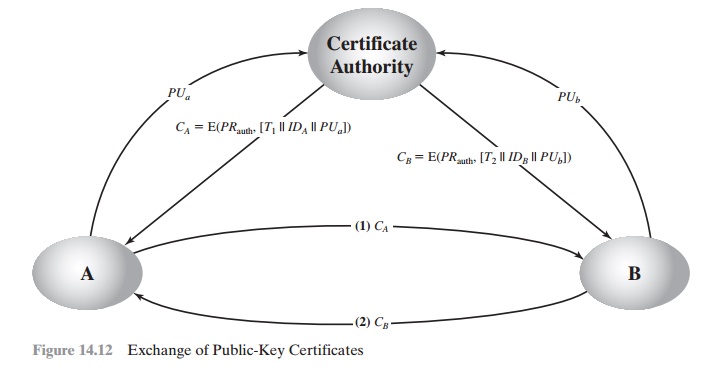Chapter: Cryptography and Network Security Principles and Practice : Mutual Trust : Key Management and Distribution
Distribution of Public Keys
DISTRIBUTION OF
PUBLIC KEYS
Several techniques have been proposed
for the distribution of public keys. Virtually all these proposals can be grouped
into the following general schemes:
•
Public announcement
•
Publicly available directory
•
Public-key authority
•
Public-key certificates

Public Announcement of Public Keys
On the face of it, the point of public-key encryption is that the public key is public.
Thus, if there is some broadly
accepted public-key algorithm, such as RSA,
any par- ticipant can send his or her public key to any other participant or broadcast the key
to the community at large
(Figure 14.9). For example,
because of the growing pop- ularity of PGP (pretty
good privacy, discussed in Chapter 18), which makes
use of RSA, many PGP users
have adopted the practice of appending their public key to messages that
they send to public forums,
such as USENET newsgroups and Internet mailing lists.
Although this approach is convenient, it has
a major weakness. Anyone can forge such a public announcement. That is, some user could pretend to be user A
and send a public key to another participant or broadcast such a public key. Until such time as user A discovers the forgery and alerts other
participants, the forger
is able to read all encrypted
messages intended for A and can use the forged keys for authentication (see Figure 9.3).
Publicly Available Directory
A greater degree of security can be achieved
by maintaining a publicly available dynamic directory of public keys. Maintenance and distribution of the public direc-
tory would have to be the responsibility
of some trusted entity or organization (Figure 14.10). Such a scheme would
include the following elements:
1.
The authority maintains a
directory with a {name, public key} entry for
each participant.
2.
Each
participant registers a public key
with the directory authority.
Registration would have to be in person or by some form of secure authenti-
cated communication.
3.
A participant may replace the existing key with a new one at any time, either because of the desire to replace a
public key that has already been used for a large
amount of data, or because the corresponding private key has been
com- promised in some way.

4.
Participants could
also access the directory electronically. For
this purpose, secure, authenticated communication from the authority to
the participant is mandatory.
This scheme is clearly more secure than individual public announcements but still
has vulnerabilities. If an adversary
succeeds in obtaining or computing the
private key of the directory authority, the adversary could
authoritatively pass out counterfeit public keys and subsequently impersonate
any participant and eaves- drop on messages sent to any participant. Another
way to achieve the same end is for the adversary
to tamper with the records
kept by the authority.
Public-Key Authority
Stronger security for public-key
distribution can be achieved by providing tighter control over the distribution of public keys from the directory. A typical scenario
is illustrated in Figure
14.11, which is based on a figure
in [POPE79]. As before, the scenario assumes that a central
authority maintains a dynamic directory of public keys of all participants. In addition, each participant reliably
knows a public key for the authority, with only the authority
knowing the corresponding private key. The following steps (matched by number to Figure 14.11)
occur.
1.
A sends a timestamped
message to the public-key authority containing a request for the current
public key of B.
2.
The authority responds with a message
that is encrypted
using the authority’s pri- vate key, PRauth.Thus,A is able to decrypt
the message using the authority’s pub- lic key.Therefore,A is assured
that the message
originated with the authority.The message includes the following:
•
B’s public key, PUb, which A can use to encrypt messages destined for B
•
The original request used to
enable A to match this response with the cor- responding earlier request and to
verify that the original request was not altered before reception by the authority

•
The
original timestamp
given so A can determine
that this is not an old mes- sage from the authority
containing a key other than B’s current public key
3.
A stores B’s public key and also uses it to encrypt a message
to B containing an
identifier of A (IDA) and a nonce (N1), which is used to identify
this transaction uniquely.
4,
5. B
retrieves A’s public key from the authority in the same manner as A retrieved
B’s public key.
At this point, public keys have been
securely delivered to A and B, and they may begin their protected exchange.
However, two additional steps are desirable:
6. B
sends a message to A encrypted with PUa and containing A’s nonce (N1)
as well as a new
nonce generated by B (N2).
Because only B
could have decrypted message (3), the presence of N1 in
message (6) assures A that the correspondent is B.
6.
A returns
N2, which is encrypted using
B’s public key, to assure B that its cor-
respondent is A.
Thus, a total of seven messages are required. However, the
initial four mes- sages need be used only infrequently because both A and B can
save the other’s public key for
future use—a technique known as caching. Periodically, a user
should request fresh copies
of the public keys of its correspondents to ensure currency.
Public-Key Certificates
The scenario of Figure 14.11
is attractive, yet it has some drawbacks. The public-key authority could
be somewhat of a bottleneck in the system,
for a user must appeal
to the authority for a public key for every other user that it wishes to
contact. As before, the directory of names and public keys maintained by the
authority is vul- nerable to tampering.
An alternative approach, first suggested by
Kohnfelder [KOHN78], is to use certificates that can be used by participants to exchange keys without contacting a public-key authority, in a way that is as reliable as
if the keys were obtained directly from a public-key
authority. In essence, a certificate consists of a public key, an
identifier of the key owner, and the whole block signed by a trusted third
party. Typically, the third party is a certificate authority, such
as a government agency or a financial institution, that is trusted by
the user community. A user can present his or her public key to the
authority in a secure manner and obtain a cer- tificate. The user can then
publish the certificate. Anyone needing this user’s pub- lic key can obtain the
certificate and verify that it is valid by way of the attached trusted
signature. A participant can also convey its key information to another by transmitting its certificate. Other participants can verify that the certificate was created by the authority. We can place the following requirements on
this scheme:
1.
Any participant can read a certificate to determine the name and public key of
the certificate’s owner.
2.
Any participant can
verify that the certificate originated from the certificate authority
and is not counterfeit.
3.
Only the certificate authority can create and update certificates.
These requirements are satisfied by the
original proposal in [KOHN78]. Denning [DENN83] added the following additional
requirement:
4.
Any participant can verify the currency of the certificate.
A certificate scheme
is illustrated in Figure 14.12.
Each participant applies
to the certificate authority, supplying a public key and requesting
a certificate.

Application must be in person or by some
form of secure authenticated communi- cation. For participant A, the authority
provides a certificate of the form
CA = E(PRauth, [T || IDA
|| PUa])
where PRauth is the private key used by the authority and T is a timestamp. A may then pass this certificate on to any other participant, who reads and verifies the cer-
tificate as follows:
D(PUauth, CA) = D(PUauth, E(PRauth, [T || IDA
|| PUa])) = (T || IDA || PUa)
The recipient uses the authority’s public key, PUauth, to decrypt the
certifi- cate. Because the certificate is readable only using the authority’s
public key, this verifies that the
certificate came from the certificate authority. The elements IDA and PUa provide the recipient with
the name and public key of the certificate’s holder. The timestamp T validates the currency of
the certificate. The timestamp counters the following scenario. A’s private key is learned
by an adversary. A gen- erates a new private/public key pair
and applies to the certificate authority for a new certificate. Meanwhile, the adversary replays
the old certificate to B. If B then encrypts messages using the
compromised old public key, the
adversary can read those messages.
In this context,
the compromise of a private
key is comparable to the loss of a
credit card. The owner cancels the credit card number but is at risk until all possible communicants are aware that the
old credit card is obsolete. Thus, the
timestamp serves as something like an expiration date. If a certificate is
sufficiently old, it is assumed to be expired.
One scheme has become universally accepted
for formatting public-key cer- tificates: the X.509 standard. X.509
certificates are used in most network security applications, including IP
security, transport layer security (TLS), and S/MIME, all of which are
discussed in Part Five. X.509 is examined in detail in the next section.
Related Topics